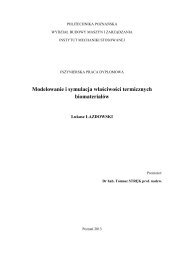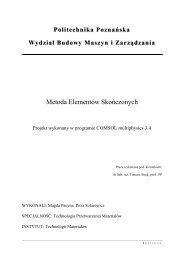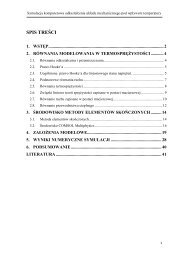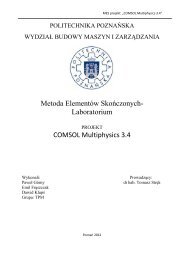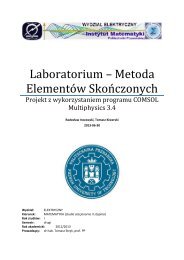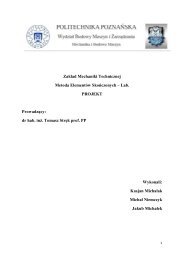Lithium-Ion Battery Simulation for Greener Ford Vehicles
Lithium-Ion Battery Simulation for Greener Ford Vehicles
Lithium-Ion Battery Simulation for Greener Ford Vehicles
Create successful ePaper yourself
Turn your PDF publications into a flip-book with our unique Google optimized e-Paper software.
AUTOMOTIVE<br />
FORD MOTOR CO., DEARBORN, MICHIGAN<br />
The 2011 <strong>Ford</strong> Fusion Hybrid, with<br />
an estimated 41 mpg in the city.<br />
<strong>Lithium</strong>-<strong>Ion</strong> <strong>Battery</strong> <strong>Simulation</strong> <strong>for</strong> <strong>Greener</strong> <strong>Ford</strong> <strong>Vehicles</strong><br />
BY CATHLEEN LAMBERTSON, CONTRIBUTING EDITOR, TECH BRIEFS MEDIA GROUP<br />
What does it mean to “go green”? For<br />
some it is as simple as putting out<br />
the recycling each week, while others<br />
choose bigger actions such as converting<br />
their entire homes to solar power. The<br />
debate over the benefits and drawbacks<br />
of environmental actions continues. For<br />
example, on one side, proponents of wind<br />
farms tout the benefits of alternative energy,<br />
while the other calls them eyesores.<br />
Consumers wonder if what they’re buying<br />
at the grocery store is really organic.<br />
When it comes to what’s truly environmentally<br />
sound, the answers aren’t always<br />
clear. But one area where progress<br />
has unquestionably resulted in a “greener”<br />
outcome is the advent of the hybrid<br />
electric vehicle (HEV).<br />
HEVs combine the benefits of gasoline<br />
engines and electric motors, and can<br />
be configured to obtain different objectives,<br />
including improved fuel economy,<br />
increased power, or additional auxiliary<br />
power. Modern HEVs use efficiency-improving<br />
technology such as regenerative<br />
braking, which converts the vehicle’s<br />
kinetic energy into battery-replenishing<br />
electric energy, rather than wasting it<br />
as conventional brakes do. According to<br />
the U.S. Department of Energy, benefits<br />
of HEVs include a reduction in CO 2 , reduced<br />
dependence on fossil fuels, and increased<br />
energy sustainability.<br />
An increasing number of automakers<br />
are now offering HEV models, with<br />
leadership held by those who entered<br />
the market early. In 2004, the world was<br />
introduced to the <strong>Ford</strong> Escape Hybrid,<br />
the first American-built hybrid and the<br />
first hybrid SUV. The Environmental<br />
Protection Agency noted that the firstgeneration<br />
Escape Hybrid was 70% more<br />
efficient than the regular Escape with its<br />
full internal combustion engine. It won<br />
the North American Truck of the Year<br />
Award at the 2005 North American International<br />
Auto Show in Detroit, MI.<br />
A Hybrid History<br />
After the introduction of the Escape<br />
Hybrid in 2004, <strong>Ford</strong> followed with the<br />
Mercury Mariner Hybrid in 2005 and the<br />
Mazda Tribute Hybrid in 2007. In 2010,<br />
the company launched hybrid versions of<br />
the <strong>Ford</strong> Fusion and Mercury Milan. The<br />
non-electrified version of the <strong>Ford</strong> Fusion<br />
and the Fusion Hybrid, with an estimated<br />
41 mpg in the city, won the 2010 MO-<br />
TOR TREND Car of the Year ® , along with<br />
a place on many “best green car” lists.<br />
The 2011 Lincoln MKZ Hybrid joined the<br />
North American lineup last fall and is the<br />
most fuel-efficient luxury car in America.<br />
All of the <strong>Ford</strong> hybrids are full hybrids,<br />
meaning they can run exclusively on battery<br />
power, exclusively on gas power, or<br />
on a combination of both. In total, <strong>Ford</strong><br />
has sold 170,000 hybrids to date.<br />
“With HEVs, it’s all about delivering<br />
and receiving energy on short time<br />
scales — high power capability — that<br />
is, breaking and accelerating. The real<br />
reason hybrids give you over 40 miles per<br />
gallon is because you’re driving around<br />
with a smaller combustion engine that<br />
is assisted by the battery on acceleration<br />
with energy from the last braking,”<br />
stated Dawn Bernardi, Ph.D., a battery<br />
8 // C O M S O L N E W S 2 0 1 1<br />
➮<br />
Cov ToC + – A<br />
➭<br />
08-11 CN <strong>Ford</strong> 2011.indd 8 5/16/11 9:13 AM



